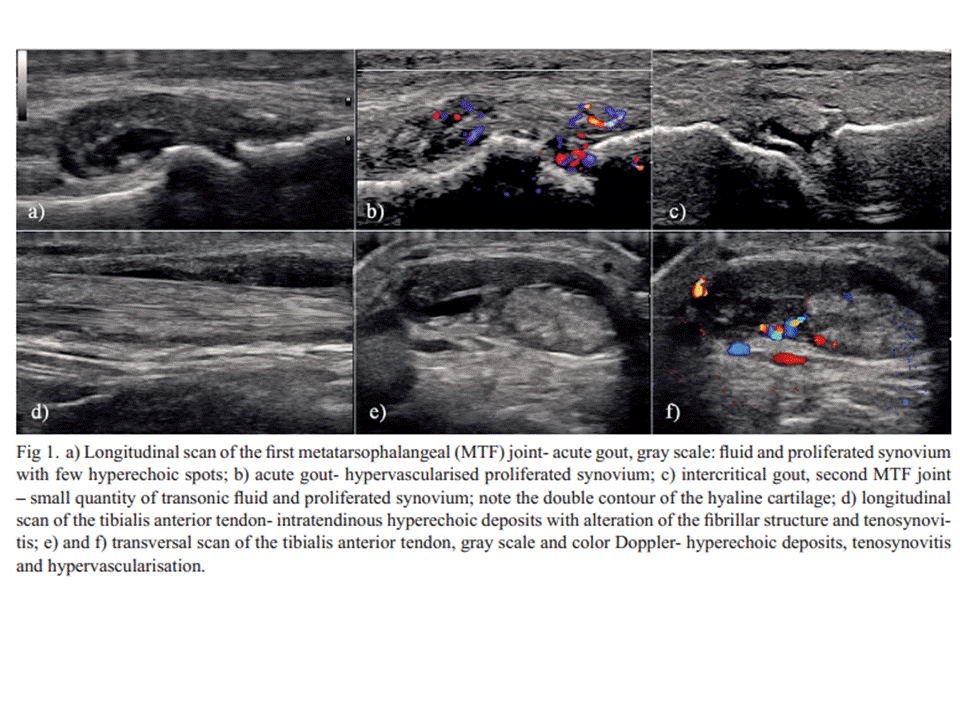Investigation questions
One of the
problems in US investigation of gouty patients is which sites to be
investigated (only symptomatic joints or structures or more extensive
examination) and what findings to be search (MSU deposits, effusion, synovial
hypertrophy, vascularisation) in order to have good sensibility and specificity
of the method. In a recent published paper by Naredo et al [17] the authors
found that US examination of 12 anatomical sites (bilateral radio-carpal joint,
first metatarsal head cartilage, talar cartilage, second metacarpal head, knee
femoral condyle cartilage, patellar and triceps tendons) for DC sign and
hyperechoic aggregates gives the best results for sensitivity and specificity
(84.6% and 83.3%, respectively). This approach had high positive and good
negative predictive values (92% and 71%, respectively) for diagnosing gout.
Peiteado et al [57] studied the presence of six types of lesions in gouty
patients: hyperechoic spots in the synovial fluid, HCA, bright stippled
aggregates, DC sign, erosions, and the Doppler signal in 17 joints and 8
tendons. They found that the knees and MTP joints are the most frequent
affected sites (in 93% of patients) and a six-minute US examination of four
joints (knees and the 1st MTPs) allowed the detection of HCA or DC sign in 97%
of cases. Clinical diagnosis of gout is sometimes difficult, even if the
manifestations are in MTF-1 (classical podagra). Kienhorst et al [58] recently
demonstrated that in patients with MTP-1 arthritis the gout was the correct
diagnosed only in 77% of cases but the general practitioner supposed gout in
98% of cases. In these cases US examination of the joint could simplify the
diagnosis process. This fact was demonstrated by Lamers-Karnebeek et al [59] in
patients with monoarthrithis in which 48% of patients had MSU crystals-proven
gout. In this cases sensitivity of DC sign and any US abnormality (DC sign,
tophi, or snowstorm appearance of the joint effusion) was 77 and 96 %,
respectively. The authors considered that the DC sign is an important
informative finding for clinician, with positive predictive value of 74 % and
negative predictive value of 78 %.
The new US
techniques probably will increase the US capacity to detect the crystals
aggregates. MicroPure, a new US image processing function designed to improve
the visualization of microcalcifications, was used by Yin et al [60] in
patients with gout. Significantly more microcalcifications were seen with
MicroPure compared to gray scale US and the level of agreement between
investigators was consistently improved. The method seems to be useful
especially for the cases where the presence of gray scale US artifacts or
unspecific findings make difficult the interpretation. The use of different
imaging methods (dual energy CT, MRI, positron emission tomography) may improve
the description of lesions [61].
The main question is if there is a really need in clinical practice for such a complex approach. The need for good education and training for identification and interpretation of the US findings encountered in gout was underline by Filippucci et al [62].The authors highlight the necessity for dedicated training-programme to avoid the false positive and false negative results. After 7 days of training the rheumatologists with limited US experience gain satisfactory skills to identify MSU aggregates in different tissues. Due to the lower diagnostic utility of the clinical gouty features (exception tophi and response to colchicine) [63], there is an incremental need for imaging techniques to confirm the clinicians’ suppositions. The place of the US in patients suspected of gout must be clearly defined [59] due to the high numbers of patients presented with monoarthritis. The research agenda concerning the use of US in gouty patients is still busy despite of the recent achievements in this pathology. In conclusion in the assessment of the gouty patients US is an important and valuable tool. For a complete examination and a correct interpretation of the imagines the examiner need to have solid US knowledge about normal and pathological aspects of the musculoskeletal structures. Knowing the specific US aspects of MSU depositions will permit a rapid diagnosis. Moreover, when combining the clinical examination with US scan in patients with suspicion of gout a proper and rapid decisions for the patient management can be taken.
The main question is if there is a really need in clinical practice for such a complex approach. The need for good education and training for identification and interpretation of the US findings encountered in gout was underline by Filippucci et al [62].The authors highlight the necessity for dedicated training-programme to avoid the false positive and false negative results. After 7 days of training the rheumatologists with limited US experience gain satisfactory skills to identify MSU aggregates in different tissues. Due to the lower diagnostic utility of the clinical gouty features (exception tophi and response to colchicine) [63], there is an incremental need for imaging techniques to confirm the clinicians’ suppositions. The place of the US in patients suspected of gout must be clearly defined [59] due to the high numbers of patients presented with monoarthritis. The research agenda concerning the use of US in gouty patients is still busy despite of the recent achievements in this pathology. In conclusion in the assessment of the gouty patients US is an important and valuable tool. For a complete examination and a correct interpretation of the imagines the examiner need to have solid US knowledge about normal and pathological aspects of the musculoskeletal structures. Knowing the specific US aspects of MSU depositions will permit a rapid diagnosis. Moreover, when combining the clinical examination with US scan in patients with suspicion of gout a proper and rapid decisions for the patient management can be taken.






Không có nhận xét nào :
Đăng nhận xét